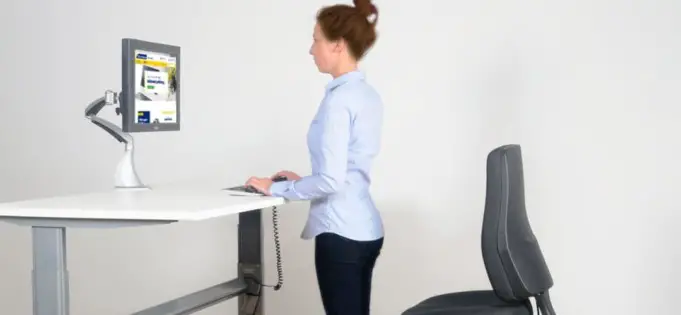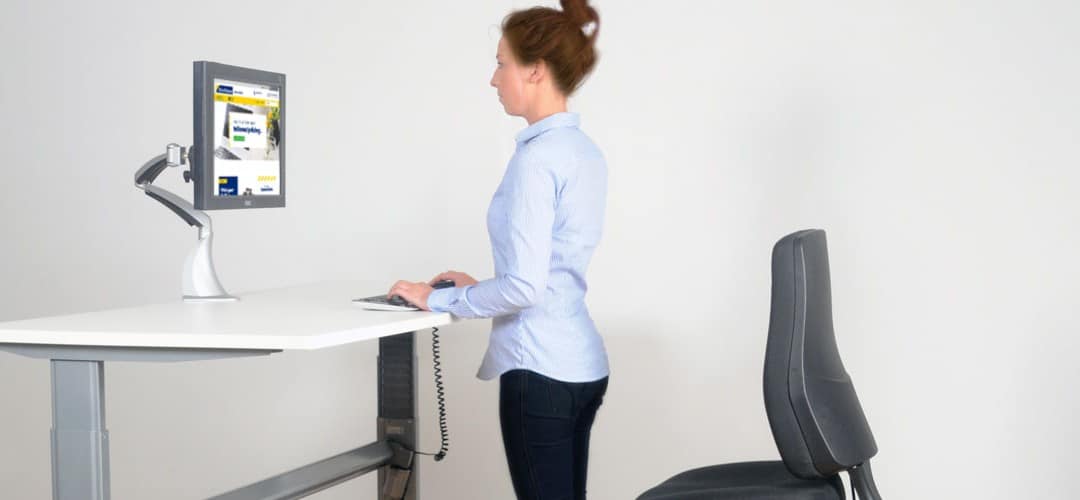If you’re worried about your health because you’re stuck at a desk all day, you’re in good company. As more and more people spend an increasing number of hours deskbound, we’re also witnessing a rise in “sitting diseases,” or health hazards and medical conditions that are caused by sedentary lifestyles. “Sitting Disease” might sound silly, but it’s a blanket term for a number of issues caused by sitting down all day, some of which are serious and even deadly.
If you work at a desk all day, one of the best things you can do to avoid sitting disease is simply stand more! It sounds like common sense, but putting it into practice inspires some good questions. How long should you stand up for? Should you stand up all day? Is it better not to sit down at all? What are some other ways to stay active at the office? And of course, how on earth can you work standing up if you work a desk job?
Don’t worry. It’s easier than you think. You definitely don’t need to stand up all day to avoid sitting diseases. In fact, it’s better if you don’t: ask a bartender or chef how hard it is to be on your feet all day! Just like sitting, standing all day is hard on your body, too. This is why research suggests finding and maintaining a balance between sitting and standing at work.
How Often Should I Stand?
They say everything is better in moderation, and when it comes to sitting and standing at work, the old adage holds true. Zen Space Desks recommends increasing your daily standing time gradually, building up to 15 minutes every 30 minutes over a 6-week period. Depending on who you ask, you’ll get different answers about the ideal ratio of sitting to standing throughout the day. But everyone agrees: switching it up between sitting and standing throughout the day will help improve overall health.
There are so many benefits associated with switching between sitting and standing throughout the day. Standing up will get your blood pumping (starting as soon as you switch!) which will help reduce your blood sugar as well as your “bad” cholesterol. This in turn will reduce your risk of heart disease and stroke. Reducing your sitting time will help keep the pounds off and keep your waistline trim, while avoiding the “dormant butt syndrome” that is a common result of underused glutes and thighs. And on top of all that, studies show that getting moving more at work will help you feel better, reducing depression and boredom, and be more productive. You’ll feel better, and you’ll look better—what’s not to love?
If you switch it up between sitting and standing, you’ll also avoid the exhaustion and sore legs and feet that come with standing up all day.
Relax into a Routine
If you’ve already got a work routine, it can be hard to get into a new flow. That’s why it’s a good idea to start slow, and work up to a new routine, breaking old habits while you’re building new ones. When you’re first starting out, there’s no reason to overdo it. Getting ahead of yourself while your body is still getting adjusted can cause you to get discouraged and burn out, which is the opposite of what you’re trying to do.
Instead, try setting alarms every hour to start with. This is a good amount of time to get a chunk of work done. When the alarm goes off, stand up to work for just five or ten minutes—maybe make a call or check your email. Once this routine becomes natural, you can try standing for longer increments, or more frequently. Changing your position every half hour is a good benchmark. Eventually, you can work up to an hourly sit-stand routine, which you can adjust depending on your body’s needs and your particular workplace.
You can work sitting down for a 15 minutes and then work standing for 15 minutes. Or you can work sitting for a half hour, and then stretch for ten minutes, and do another twenty minutes of standing work. Maybe you feel more energetic when you first get into the office, so you can start your day checking your email standing up. These are just suggestions to get you started standing more. Your body and needs are unique, so your routine should be too. Try different combinations until you find what feels right!
There’s An App for That!
We know how hard it is to break old habits, but you don’t have to do it alone. It can be as simple as setting a kitchen timer, but there’s also plenty of other kinds of tech that can help you with sit-stand reminders. There are apps that can track your workplace habits, and send you notifications to stand up at intervals you set. You can also use wearable devices like a Fitbit to track your activity and remind you to move more.
You also might want to consider buying or making a sit-stand desk, which will make it as easy as possible to make the sit-stand switch without interfering with your work. You can improvise your own sit-stand desk with something as simple as a milk crate, but there are tons of options on the market that allow you to perfectly customize your workspace. There are even mats that are specially designed to keep your feet comfy during your standing hours! Whatever the sit-stand routine you choose, just know that there are tools to make it easy for you.
Posture Makes Perfect
Whether you’re sitting or standing, it’s critical to watch your posture. Avoid leaning, slumping, and craning, all of which are hard on your neck and back. Your arms should be at a 90 degree angle to your keyboard, and your monitor should be level with your face, to keep from straining your neck. Wear comfortable shoes that support your arches, and don’t forget to rest your eyes periodically if you’re staring at a screen too long.
If you find yourself getting tired in any one position, just switch it up! Moving more is always a good thing!
Author Bio:
Brendan is an Exercise Physiologist with a Bachelor of Applied Science (Human Movement Studies). AEP ESSAM. He is a regular contributor at Best Doctors & operates a number of clinics for Livewell Rehab. Health Motto: Exercise isn’t a chore- Make it fun!













